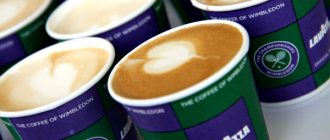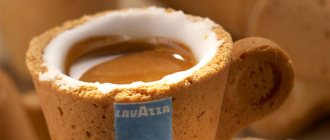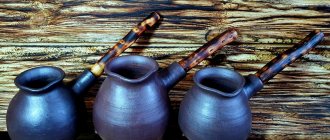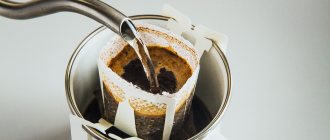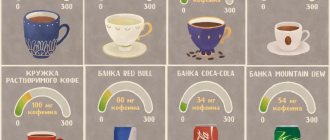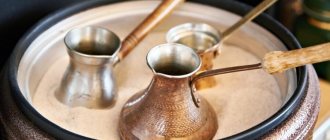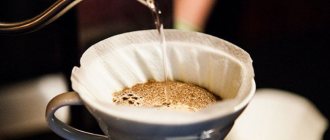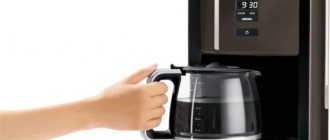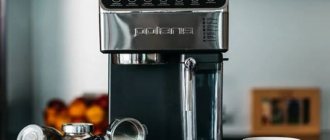The filter is the main element of the coffee maker. It separates the grounds formed from ground coffee from the resulting drink. The quality of the filter directly affects the properties of the cup of joe. Therefore, the filter must be chosen responsibly.
It strains out oily components, allows aromatic components to pass through, saturates O2, and also retains solids, preserving the taste.
We can make the filter ourselves. But only a paper filter can be made independently.
They also produce filters from metal (titanium, stainless steel), fabric, nylon, plastic, ceramics, porcelain and glass.
The filter is used in such brewing devices as drip coffee maker, Chemex, Aeropress, Kalita, Hario V60 funnel, Bonavita immersion funnel.
Coffee from such devices is called filter coffee.
Depending on the service life, the filter can be disposable or reusable.
Purpose of filters
What is a filter for? Coffee is actually water that has passed through the powder (ground roasted coffee beans separated from the peel) and picked up all the flavor and aroma composition along the way. This process occurs differently in different types of coffee makers. In particular, in drip-type devices, ground coffee is placed in a filter, water passes through it under pressure and flows in drops into a special container for the finished drink.
After preparation is completed (this process is called percolation), the filter along with the used powder is removed and cleaned or thrown away in order to install a new one of the same product in its place. Thus, this element is an integral part of the design and is needed, among other things, to ensure that the grounds do not mix with the coffee. After all, not everyone likes it when there are solid particles in their drink.
The filter prevents solid particles from getting into the finished drink
Which coffee makers use filters?
Filter coffee maker is a collective name for all devices in which coffee beans can be prepared. We experimented with teapots in ancient times, but then an electric model was invented - a drip coffee maker.
Drip
The principle of a drip coffee maker is simple: a paper filter is installed in a coffee container, then ground beans are poured. As the water heats up, it begins to wet them and flow into the cup as a finished drink. Without pressure it turns out weak, but many people like it. After use, the grounds and paper are thrown away.
Vietnamese Finn
It is more difficult to work with a Vietnamese Finn - those who have been to Vietnam know that it is not possible to brew coffee correctly the first time. You need to study for at least a couple of days. This device also uses a filter, although for sale to tourists this part was replaced with a metal strainer for reliability, it can be sold more efficiently.
Purover
The pour-over is somewhat reminiscent of a Finn in shape, but it’s easier to use - put a filter on, pour in some grains and pour boiling water over it. The water will not pass through the coffee tablet immediately, but will linger a little in the grounds. This is what is needed to get the aroma.
Types of coffee filters
The main principle by which filter elements are divided is the material from which they are made. Each of these has its own advantages and disadvantages. Which one to choose is up to the owner of the coffee maker to decide.
There is another classification - digital. For example, the filter says “size 4”. What does it mean? It's simple. The number means the number of cups of coffee for which the powder poured into the filter is enough . That is, the difference between coffee filters 2 and 4 is that the first is designed for ground coffee, which is enough to prepare two standard cups of coffee, and the second, respectively, for four. The most common ones are “fours,” but you can also find “ones,” “twos,” and “sixes” on sale without any problems.
If the capacity of the coffee maker is 600-800 ml, then buy No. 2, and if it is 1-2.2 liters, then buy No. 4.
Paper
This is the most common option. Paper filters for drip coffee makers are disposable. That is, after each use, such a product must be thrown away and replaced with a new one.
Paper coffee filters have undeniable advantages:
- absence of foreign tastes and odors that may be noticeable in other products even with good care;
- the white or light brown paper used for production (special, with characteristics selected specifically for this process) not only separates the grounds from the liquid, but also perfectly retains all harmful elements (caffeol, coffeestol and oils, which can increase cholesterol levels in the body) ;
- this is a biodegradable material that, after being thrown away, disintegrates quite quickly on its own and does not pollute the environment;
- Harmful bacteria do not multiply on the surface, and the appearance of an unpleasant odor is excluded.
The only drawback stems from the main feature. You need to make sure that you always have a supply of these filters at home, and if necessary, purchase these consumables (otherwise you simply won’t be able to make coffee). Although the price is very low.
Paper filters are easy to use
Fabric
Made from natural cotton, hemp or muslin fabric. The pore size is larger than that of paper counterparts. Therefore, a small amount of sediment is noticeable in the finished drink. When the fabric turns brown, the product needs to be cleaned. The average period of use is 3-6 months. However, in our country such filters are very rare - they are not widely used.
Fabric filter
Nylon
Such an element is usually supplied with the coffee maker. It has a plastic body, which is covered with synthetic material (nylon). If treated with care, they can “last” for quite a long time - you don’t need to constantly buy them, and this promises to save money. Average resource - up to 60 brews (with proper care - up to 80-100). However, you must take good care of the filter, in particular, thoroughly clean and rinse it. Otherwise, an unpleasant odor will quickly appear, which will indicate the development of microorganisms, which, of course, should not be there. This will also affect the taste of the finished coffee. In addition, only coarse powder can be used in nylon filters. Coffee ground “to dust” is not suitable, since the filter will allow a lot of solid particles (grounds) into the cup. In addition, nylon, as an artificial material, decomposes very poorly in the environment, and waste recycling in our country, unfortunately, is practically undeveloped.
Filter sizes and useful tips
The filter size for the coffee maker is indicated on the package by the manufacturer. Depending on the required number of servings of finished coffee, the appropriate parameter is selected. It can be from one to 12 cups. Universal disposable filters for coffee makers have appeared on the market, which are suitable for all types of devices and are sold in packs of 100 pieces.
If the filter fails and you need coffee very urgently, you can use cardboard napkins, calico or cotton cloth, or gauze folded in several layers.
Greenish tea tastes amazing and has a subtle aroma. Active composition and method.
Hua Li Zhi (jasmine pearl) tea is a unique variety of greenish tea. This drink has...
Most people associate Eastern tea traditions only with China. Not enough people know that in the Land of the Rising Sun there is more tea.
The beginning of the history of the Fortnum&Mason brand can be considered in 1707. This year William.
Coffee is quickly gaining popularity among the population, which is not mind-blowing, because this drink has.
Most of the inhabitants of Italy believe that the most delicious and real coffee is prepared exclusively in.
One of the most popular cocktails of its kind is coffee with cognac. In making it.
Not long ago, English researchers at a scientific nutrition center managed to obtain a rather unusual drink.
The widespread introduction of innovative technologies has affected all spheres of life. Now in everyday life.
Any coffee machine requires constant maintenance from its owner. This.
Many coffee lovers want to enjoy the taste.
Every year, super-automatic coffee machines are becoming more and more popular. In this article we will talk about.
There are a number of types of coffee makers: carob, drip, geyser.
There are four types of coffee makers: drip.
A geyser-type coffee maker allows you to prepare coffee in...
Coffee is presented on store shelves in incredible abundance. Demand gives birth.
How can you change a coffee filter?
As soon as coffee lovers wake up, they immediately head to the kitchen. Imagine that you did exactly that, but found that the coffee filters had run out and you couldn’t make coffee. There is no time to run somewhere to the store before work. And a morning without coffee is not a morning. What should I do? Replace the filter with something similar!
How to make your own filter
Instead of buying a ready-made element, you can save money by making it yourself. So, how to make a filter yourself:
- take plain paper, making sure that it can allow water to pass through;
- use paper towels or napkins;
- use cotton or chintz fabric (for example, cutting an unnecessary sheet). To do this, you need to fold it in one or two layers;
- buy or find a gauze bandage at home. Rinse it first to remove the smell;
- the nylon from which women's tights are made allows water to pass through and retains unnecessary impurities.
However, in any case, homemade products are a “one-time” way out of the situation when you run out of filters at home and want coffee. It cannot completely replace a factory product.
How to get rid of the taste of cardboard?
Rinsing the filter before use will not only help you prevent unwanted flavors from appearing in your cup, but will also help warm up your coffee utensils. The washing procedure is simple and probably already known to many:
- Place the filter in your coffee brewing device (coffee maker, V60 funnel or any other gadget)
- Wet the filter by running plenty of hot water through it (make sure you wet the filter completely)
- Drain the water
- If necessary, repeat rinsing again
- Continue brewing coffee as usual
Most often, washing the filter once is sufficient, but if you still notice foreign odors, the procedure should be repeated twice. If double washing does not help, it is better to use filters from another manufacturer.
Maintenance and operation
To avoid the formation of an air lock, the internal filter is filled with water before installation and placed in a full tank. The devices do not require any maintenance.
Replacement frequency
| Filter brand | Model | Approximate service life (when processing an average of 10 liters of water per day) |
| Internal filter | ||
| DeLonghi | DLS | 60 days |
| Krups | Claris | 60 days |
| Saeco and Philips | Brita Intenza+ | 60 days |
| Bosch | Claris, Brita Intenza | 60 days |
| Jura | Claris | 60 days |
| Brita | AquaGusto 100 | 180 days |
| Main filter | ||
| Brita | Purity C300 | 1.5 years |
| Aquaphor | Morion DWM-101S | 6 months |
Dismantling the device and installing a new one is carried out according to the instructions. There is nothing complicated about the procedure.
Attention!
Regular replacement of the cartridge cannot be postponed until later. A clogged filter stops allowing water to pass through, which can cause damage to the hydraulic system.
Characteristics of Delonghi, Krups, Saeco and other cleaners
| Manufacturer | Product line | Peculiarities | Job resource | Price, rub.) |
| DeLonghi (Italy) | DLS | Delonghi 002 series for descaling. Performs the function of demineralization (softening) of water. Compatible with ETAM, ECAM, ESAM machines. | 50 liters | 1990 |
| Krups (Germany) | Claris | For Krups coffee machines. Removes chlorine, pesticides, impurities, and gets rid of plaque. Retains the full composition of minerals. | 50 liters | 2190 |
| Royal Philips / Saeco (Netherlands) | Philips Saeco AquaClean, Brita Intenza+ | AquaClean for coffee makers CA6903/10 and CA6903/00, all Philips EP models... The line removes mechanical impurities and scale. It has a longer working life - 3 months without replacement, versus 2 months for Brita Intenza+. The Brita series is available for CA6702/10 and CA6702/00 machines. Provides protection against plaque. Brita has a filter hardness setting feature. | 50 liters | 1300 |
| Bosch (Germany) | Brita | Brita Maxtra (for Filtrino, Tassimo) is used to remove scale. The Brita series is equipped with a stiffness adjustment ring. Removes chlorine and other impurities. Prevents plaque formation. Designed for TCA7…, CTL6, TES5/6/7/8… | 50 liters | 800-1000 |
| Jura | Claris filter family (Smart, Blue, White) | Devices are cleaned of mechanical impurities and descaled. All filters have the same resource: 50 liters or 2 months. Cartridges differ in the shape of the connecting socket. The Smart line is adapted for Jura after 2015 release with the IWS system. The Blue hex series is used in Jura 71311, 67007. The White series with round socket is for machines manufactured before 2010. | 50 liters | 1300-1700 |
| Brita (Germany) | AquaGusto 100 | Anti-scale filter for all espresso coffee machines. Water purification speed up to 25.8 liters per minute. Does not require an adapter when installing. No assembly required. Fits freely in the water tank. | 100-250 l | 659 |
| Purity family of professional filters | Quell ST main line for reducing hardness, improving the taste and aroma of water. Fresh C50 - for soft water. C Finest - for making espresso. | 960–11500 | 10000-16500 |
Coffee machine repair technicians recognize the need for water treatment to purify and soften water, but note the widespread custom among consumers of not changing the cartridge on time, which causes the hydraulic system of brewing units to become clogged with solid deposits of magnesium and calcium salts.
Purifier functions
Installing the device allows you to:
- remove harmful impurities from the liquid;
- prevent the formation of plaque on the walls of the boiler and heating elements.
Without a filter, water with harmful substances goes directly into the cup. And due to the hardness of the liquid, solid deposits appear inside the equipment.
They lead to reduced performance of heating elements, clogging of internal parts and the appearance of flakes in the drink.
Important! Scale buildup is a common cause of equipment failure.
If the coffee maker is not equipped with a filter, after 2-2.5 years it has to be sent for repair to clean it from plaque.
Water with impurities itself spoils the taste of the best coffee. Therefore, a water treatment device is a mandatory element for equipment in which high-quality drinks are prepared. To remove deposits, consumers use special tablets and liquid solutions produced by coffee maker manufacturers:
- Bosh;
- De Longhi;
- Philips Saeco;
- Jura.
The price of the funds ranges from 200 to 1000 rubles. Cleaning is carried out after 200 cups.
An alternative to filters is bottled water. The use of liquid in purchased containers has disadvantages - the impossibility of adjusting the degree of purification, the risk of purchasing a low-quality product, and biological contamination of plastic containers during operation.
Filters for coffee machines price category over 2000 rubles
Professional Jura Claris Pro Blue 71702
The development of Swiss manufacturers is focused on special equipment that belongs to the professional line. It features new water protection technology.
The body contains a mineral substance that affects the release of calcium carbonate. Thanks to this, scale does not form and the performance of the coffee machine does not deteriorate. The model is effective under heavy loads in daily use.
Advantages:
- cast ribbed body with good stability in the device;
- the upward flow principle is activated;
- a new type of proprietary cleaning system is used;
- mineral beneficial compounds are preserved;
- stabilization of calcium carbonate is ensured.
Flaws:
- average cost is about 3000 rubles;
- Only works with GIGA/XJ series machines.
Filters for coffee machines in the mid-price category – 1100 – 2000 rubles
Model KRUPS Claris F08801 with memory
Modern equipment for water purification, even mini-format, shows good results, which allows you to enjoy delicious coffee every day.
This device has two-stage filtration that allows you to get rid of not only scale-forming particles, but also some chemical elements that impair the quality of the drink. At the same time, beneficial substances are completely preserved. The service life of the product is 2 months.
Advantages:
- high-quality plastic housing;
- use of activated carbon for absorption;
- ability to reduce carbonate hardness of water up to 75%;
- the presence of a memory mechanism with input of dates of start of operation and expected replacement;
- Suitable for a wide range of XP and EA series coffee machine models;
- average cost 1700 rub.
Flaws:
- not detected.
Filter cartridge NIRF 700 Claris for Nivona coffee machines
The model fully meets the design features of the coffee machine of this brand. Using a thread printed on plastic, the filter cartridge is effortlessly and quickly screwed into a container of water.
The housing is quite hygienic and does not contain harmful chemical additives. Owners of coffee machines note that the device significantly slows down the formation of sediment in the form of scale. Timely replacement of the cartridge allows you to use special means to remove it only once a year.
Advantages:
- the body is made of health-safe plastic;
- no additional filter maintenance required;
- Can be used even for very poor water;
- compactness of the device;
- convenient protective packaging;
- cost from 1500 rub.
Flaws:
- limited use of Nivona equipment.
READ ALSO
10 best cappuccino makers
Claris Smart 71793 for espresso machines from 2015
This is an innovative device that is adapted for certain models of Jura equipment. It integrates advanced RFID technology.
The “smart” device independently determines whether a filter is installed and sets the optimal operating mode. There is no need to constantly remember to change the device: it will remind you of this itself after the useful resource is exhausted. Dosed water supply guarantees its purity and excellent taste.
Advantages:
- the body is made of wear-resistant material;
- indication of the need to replace the filter;
- monitoring the correct installation of the device;
- the water in the filter does not stagnate;
- heavy metals and harmful substances do not end up in the final product;
- average cost 1400 rub.
Flaws:
- compatibility is limited to Z6, E6, E8, E60, E80 models starting from 2015;
- with a shelf life of 10 years, replacement is performed every 2 months or 50 liters.
READ ALSO
15 best electric kettles
How to choose?
There are two types of water treatment devices:
- internal - installed in the tank of the car;
- main - connected to a pipe with cold water, which is supplied to the coffee maker.
Internal devices have a short working life and are used in home equipment.
Main filters are characterized by high performance and are used when servicing professional equipment for coffee shops with high traffic. Both types of filters are not supplied with the drink preparation units, but are purchased separately.
What should you pay attention to?
Important characteristics of the devices:
- Filter compatibility with coffee maker series.
- Price.
- Working life (maximum volume of liquid for water treatment).
The cost of internal appliances ranges from 1000 to 3000 rubles.
Benefits of the best filters:
- Quick installation and cartridge replacement - within 30 seconds.
- It is possible to configure the filtration mode according to the water hardness level.
- High quality cleaning.
- Availability of an indicator of cartridge operation time and replacement.
Not all devices have the same cleaning quality: some only soften water, others retain:
- rubbish;
- impurities;
- bacteria;
- nitrates.
Therefore, when choosing a filter, you should pay attention to consumer reviews and read the manufacturer’s instructions indicating the purpose of the model.
To check the quality of water treatment, many manufacturers supply test strips with their devices. The indicator paper is glued to the manufacturer's instructions or to the warranty card.
Nuances of choosing main water treatment devices
Characteristics of flow-through units that you should pay attention to when purchasing:
- Set of functions: cleaning from chlorine, softening hard water, removing odors, etc.
- Model resource: 1000 or more liters.
- Price.
- Maximum output: liters per minute or cups per hour.
- Size and shape of fitting for connection to communications: 3/8″, etc.
- The presence or absence of a tap for filtered water.
On a note!
Trunk installations also differ in the method of connection to the system: vertical or horizontal.
What is a carob coffee maker, types of carob coffee makers
The main feature of any carob coffee maker, SUDDENLY, is the presence of a “horn”. To put it simply, it is a handle, at the end of which there is a round filter holder where a coffee tablet is placed.
Primary, home class: filter diameter 50-54 mm.
The first and main parameter by which carob coffee makers are divided into subclasses and by which one must choose is the pressure developed and the method of achieving it.
1. Pumpless, also known as boiler coffee makers - they do not have any device that increases the pressure of boiling water. They have a metal boiler with a heating element into which water is poured. When boiling, steam forces water through the valve into the horn. The pressure in such coffee makers is usually around 2-4 bar, and it cannot be higher purely by design.
For canonical espresso, the water pressure in the brewing group should be 8-9 bar. Accordingly, pumpless carob coffee makers, in principle, cannot make proper espresso, and are designed to brew something between a strong Americano and the product of a geyser coffee maker.
This type is the only exception to the “carob coffee maker specializes in espresso” rule. I believe that buying such equipment is a serious compromise that has its place, but it is better to avoid it if possible. Examples of such devices: Scarlett SC-037 (review), Redmond RCM-1502 (review), Polaris PCM-4002A (review).
2. Pump carob coffee makers , in which the pressure in the coffee tract and brewing chamber is ensured by the operation of a water pump. Based on the type of pump, these coffee makers are divided into two more subclasses:
- Home/household/primary/middle class. Sign: use of a vibration pump in the design. In such pumps, water is pumped by the method of “oscillation” (movement) of a piston in a magnetic harness up and down (or left and right). Such pumps are used in all home coffee makers and coffee machines for at least 5 (for example, Vitek VT-1511), at least for 200 thousand rubles (for example, Jura Z10). They have a specific disadvantage: the pressure developed by the oscillation method is discrete, it is not strictly uniform. But such pumps are cheap and compact. For a beginner, the downside of vibration pumps is almost invisible. If only because in this class of devices this is far from the only “simplification” used in espresso coffee makers, and compared to the rest it is not something particularly critical.
- Professional/Commercial/Industrial Grade. Feature: used in the design of a rotary pump. In them, the motor turns the impeller, which scoops and pushes water further along the hydraulic circuit, and at a constant speed. Therefore, the pressure is stable and uniform. Pressure uniformity is one of the important parameters that positively influences the final taste of espresso. Such pumps are noticeably more expensive and physically larger; accordingly, they are used in heavy, professional carob coffee makers for use in coffee shops, restaurants, etc. A typical example is Nuova Simonelli Appia II. It is clear that perfectionists among coffee lovers use professional single-point horns at home as well.
3. An extremely professional subclass of carob coffee makers, divided into a separate class - lever coffee makers. In these horns, pressure is achieved and adjusted by the user by pressing down on a large, mechanical lever with his hand. They provide very fine “tuning” of the extraction process, but require maximum skills from the barista. Espresso coffee makers with the least degree of process automation. I’ll say right away that in light of the unusually low popularity and prevalence of lever coffee makers, I will not dwell in more detail on this class, but for clarity, I will insert an excerpt from the film “Live and Let Die”, where Roger Moore in the role of James Bond brews coffee on a lever La Pavoni Europicolla:
I also warn you that the subclass of professional/commercial horns is worthy of a separate material, which will be written sometime later (in which case a link will appear here). And I will dwell in more detail on the class of home/beginner carob-type coffee makers.
